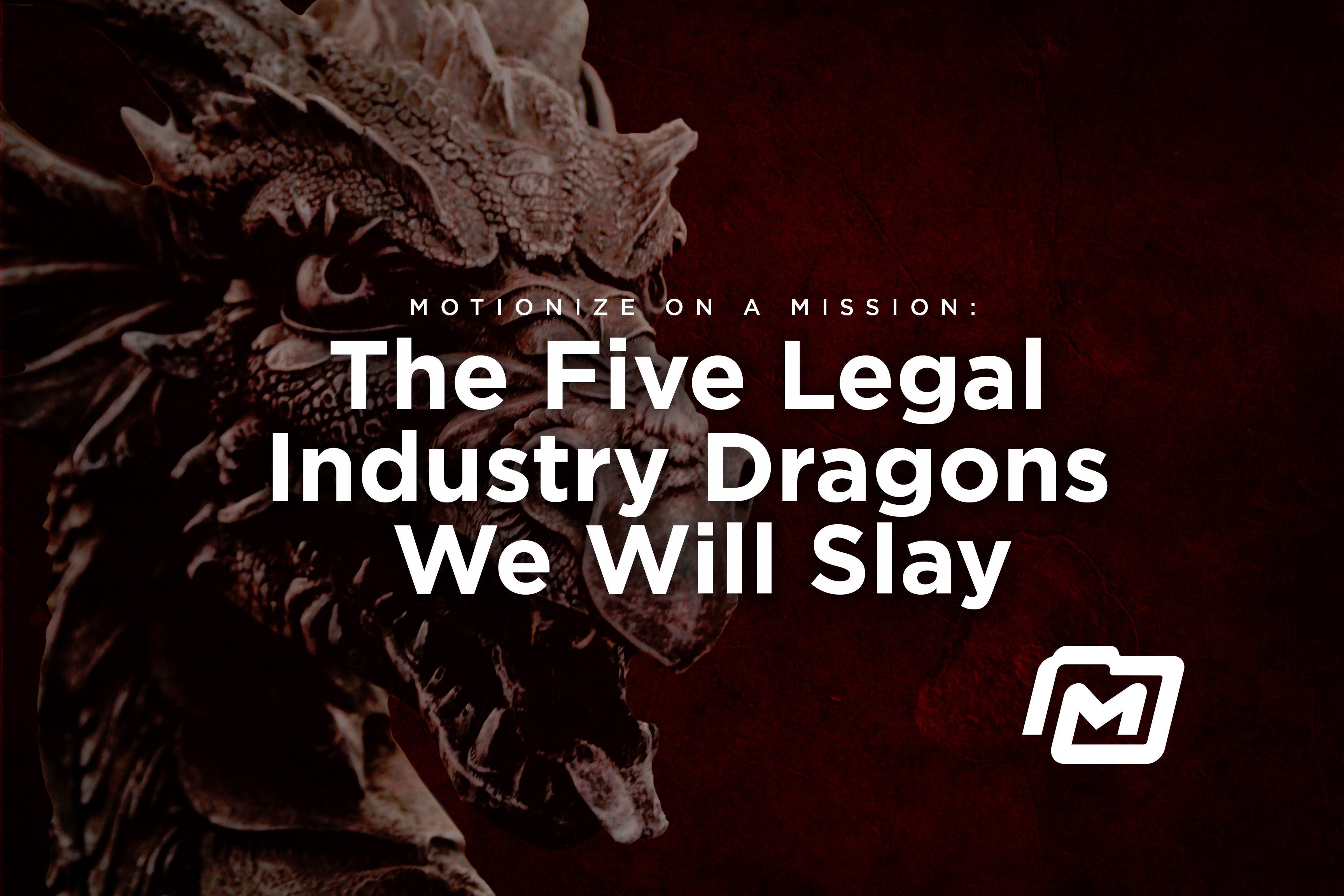Recent Posts
 February 01, 2021
February 01, 2021
 0
Comments
0
Comments

When Luke Waltman and I started Motionize, all we knew was that we wanted to build a solution that made the law work better. After a circuitous route and early naiveté, we have begun our hero’s quest. No longer in the Shire, we are off slaying the dragons that have plagued the legal industry. These dragons have made legal work suck and clients frustrated with the inefficiencies of law.
We’ve had our first skirmishes with these beasts, but will not stop until these five horrible denizens of legal drafting are conquered.
Here are the five legal industry dragons we will slay:
Dragon I: The Time Lost on Inefficient Drafting
Law practice, for solos and three-member firms, involves many moving parts and near-daily conflict resolution. Caseloads are heavy, appearances shift from court to court, motions are due, deposition prep looms, negotiations are ongoing…and so on.
Time is a precious commodity for attorneys and paralegals. Spending more time over here means spending less over there. Wasting time means everyone loses.
Recapturing the time of these clients using legal document automation tools is the most important thing we can do. For these professionals, newfound time isn’t just saved money. It is the easing of tension, the peace of mind that frees up energy for other tasks.
Test out the Motionize ROI Calculator to find out more.
Dragon II: Broken Software and Broken Integrations
The goal of any professional services-oriented software solution should be to make the work lives of the people who use it easier. To best accomplish that goal, the solution cannot be an ongoing saga of complex implementation and training. The solution also can’t clash with other technologies in use or require multiple Excel-driven data migrations.
Thus, a document automation tool should integrate with a case and matter management tool like Clio or Practice Panther to flow the necessary case metadata in without complication. It should also integrate with NetDocuments and other Enterprise Content Management systems to support the management of firmwide structured data. Whether a firm chooses a platform solution or a series of point solutions, everything needs to work together.
Busy professionals do not like inconvenience or disruption. Neither do we, which is why we have designed Motionize to be part of an end-to-end firm technology enterprise.
Dragon III: Remote Collaboration
Cloud-based relational databases, document management systems and collaboration tools like Slack and Zoom have been easing their way into law firms for years. Before COVID-19 hit, they were perhaps seen more as nice-to-haves than need-to-haves.
The pandemic forced a shift in attitudes. Business continuity dictated that the storage of access to and completion of legal work from a remote location were unavoidable. Those of us non-essential enough to work from home, or whose clients were stuck at home, or who suddenly had no local courtrooms to enter hurriedly found sustenance through web browsers.
The reality of COVID-19 reinforced that document automation is part of a larger document creation process that needs to include centralized data management and a default to the cloud.
A document automation system, we found, should also include places to reuse document templates and store created work product. While attorneys may really want to function in a physical office, a hybrid reality is most likely moving forward.
Dragon IV: Bad Business Software Designed for the CIO and Not the User.
Technology is best adopted when it folds into the comfort of the familiar. A clean, lovely user experience that resembles a five-click Amazon phone app session will always be a draw (or “magic,” as one test user told us).
Even so, anything that takes considerable process re-jiggering or 20-step prepare-to-use workflows before the good stuff will be less likely to take hold. Self-service technology helps prevent that scenario.
Motionize, for instance, creates metadata fields automatically upon upload. It builds in a word-processing environment that replicates the Microsoft Word environment. We’ve also begun work on a machine learning-driven tool for auto-formatting documents to comply with specific court requirements.
We have no intention of scaring off any of our users.
Dragon V: Accepting the Status Quo.
Document automation tools are a wonder, but they do not complete 100 percent of the work. They will never be perfect.
There will be some editing and some formatting necessary after the fact. Templates will need to be further customized further after the machine does its part. There will need to be internal workflow adjustments.
As long as we keep listening to our customers, and don’t pretend to have all of the answers, ourselves, we’ll continue to develop the best platform we can.
Why? Because automation gets our clients most of the way to where they need to be. It fills in all the blanks in the template to cut down on repetitiveness. It normalizes work product and gives associates and paralegals exemplars to work with from the start. It creates motion without sputters.


 by
by